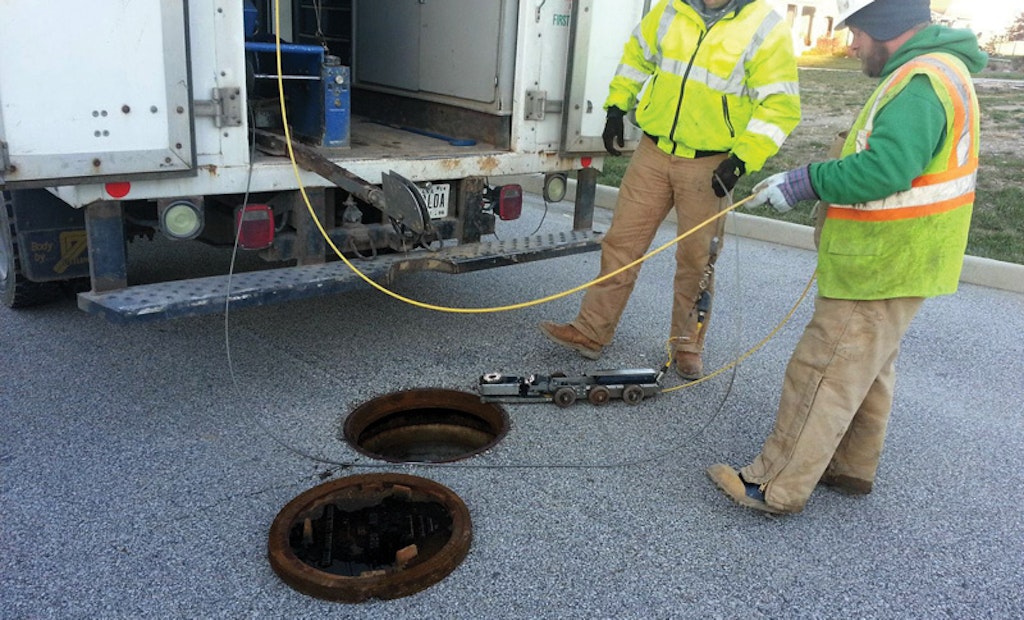
Interested in Trucks?
Get Trucks articles, news and videos right in your inbox! Sign up now.
Trucks + Get AlertsThe Gen2 mainline and lateral-launch video-inspection camera owned by Eco Infrastructure Solutions Inc. in Lebanon, Ind., is dwarfed by the much larger vacuum trucks that produce the bulk of the company’s profits. But its impact on the company is huge nonetheless.
“The inspection camera system makes money for us, for sure,” says Jay Paul, vice president of field operations for the firm, based in Lebanon, Ind., on the northern edge of Indianapolis. “But it really benefits us by providing opportunities to bring in our vac trucks or do repair work. The lateral launch itself is not the big bread-winner. But it generates much more profitable work for other aspects of our company.”
Made by RS Technical Services Inc., the truck-mounted camera system inspects mainlines from 6 to 24 inches in diameter and laterals from 4 to 8 inches in diameter. The six-wheeled mainline camera unit offers a 40:1 zoom lens with pan, rotate and auto-focus features; the lateral-inspection camera features a high-resolution camera with auto-upright capability. The primary unit can inspect up to 500 feet of mainline sewer and the lateral inspector can examine up to 150 feet of pipeline. The camera inspection system is housed inside a 12-foot box body made by Supreme Corp. and mounted on a Ford F-450 truck chassis, Paul says.
Eco Infrastructure, which also owns three vacuum trucks – two made by Vac-Con and one by Vactor Manufacturing Inc., plus a Mustang lateral water jetter – bought the Gen2 system four or five months ago. But in that short time period, it has proven itself as a valuable tool. One of the main benefits: It eliminates the need for homeowners to be present for lateral inspections, says Jeff Brooks, a salesman for Eco Infrastructure. The company’s primary focus is pipeline inspections and repairs, mostly performed for municipal and commercial clients around the state of Indiana and the metro-Chicago area.
“That’s a huge time saver,” he explains. “Before, if a homeowner had a clean-out in the basement, we used a standard RST push camera for lateral inspections. But if there was no clean-out inside, we either had to install one [outside], which could set us back anywhere from a half day to a full day. Or we just couldn’t do an inspection. Moreover, sometimes homeowners don’t want an inspection because they have an illegal tap they want to keep.
“If a municipality is paying us ‘x’ amount of money per foot or per lateral to do inspections, we lose revenue if we can’t get inside,” he continues. “And if we can’t do an inspection, we lose out on repair revenue, too. But with the lateral launch capability, we can go in from the mainline whether someone is home or not. The homeowner never knows we were even there. And we don’t waste time hunting for clean-outs, either.”
In addition, if a technician uses a push camera to inspect the line from the clean-out to the street, there’s usually water in the pipe from the blockage, which dramatically limits visibility, Brooks adds.
Overall, Brooks estimates that the lateral launch capability has increased the company’s inspection productivity by two- or three-fold. And that, in turn, has boosted profitability, Paul notes.
“It’s hard to put an exact number on it, but it has increased our profitability significantly,” he says.
Brooks and Paul say that lateral infiltration and inflow is prompting more and more demand for inspections in their service area. Many communities have already televised and repaired their mainline sewers, so examining laterals to stop stormwater inflow is the next logical step.
Paul also lauds the system’s high-resolution video quality and expansive reporting capabilities.
“The operator is sitting with a full-blown computer and can include any comments he wants,” he says. “And we can put the report and video on all kinds of media for customers to view. For a municipality, we’ll put all the lateral-inspection videos on a one-terabyte hard drive. For smaller commercial customers, we can put it on a thumb drive or a DVD. Sometimes we even upload inspection videos to YouTube and send the customer a link for viewing. It’s great for instances when we run into a major problem that a customer needs to see ASAP, like a collapsed line or a cross-bore from a gas line.”
Brooks and Paul agree that staying ahead of the technology curve is important because competition is fierce. Moreover, multiple capabilities make the company attractive to customers who prefer one-stop shopping for services, they add. Throw in the increased efficiency angle and it’s clear why new, advanced equipment makes a difference.
“We may not be the cheapest guys out there,” Paul concludes. “But if we can do a job quicker than our competitors and still maintain quality, then we’ve become cheaper. The Gen2 with lateral launch has definitely been a good investment for us.”





